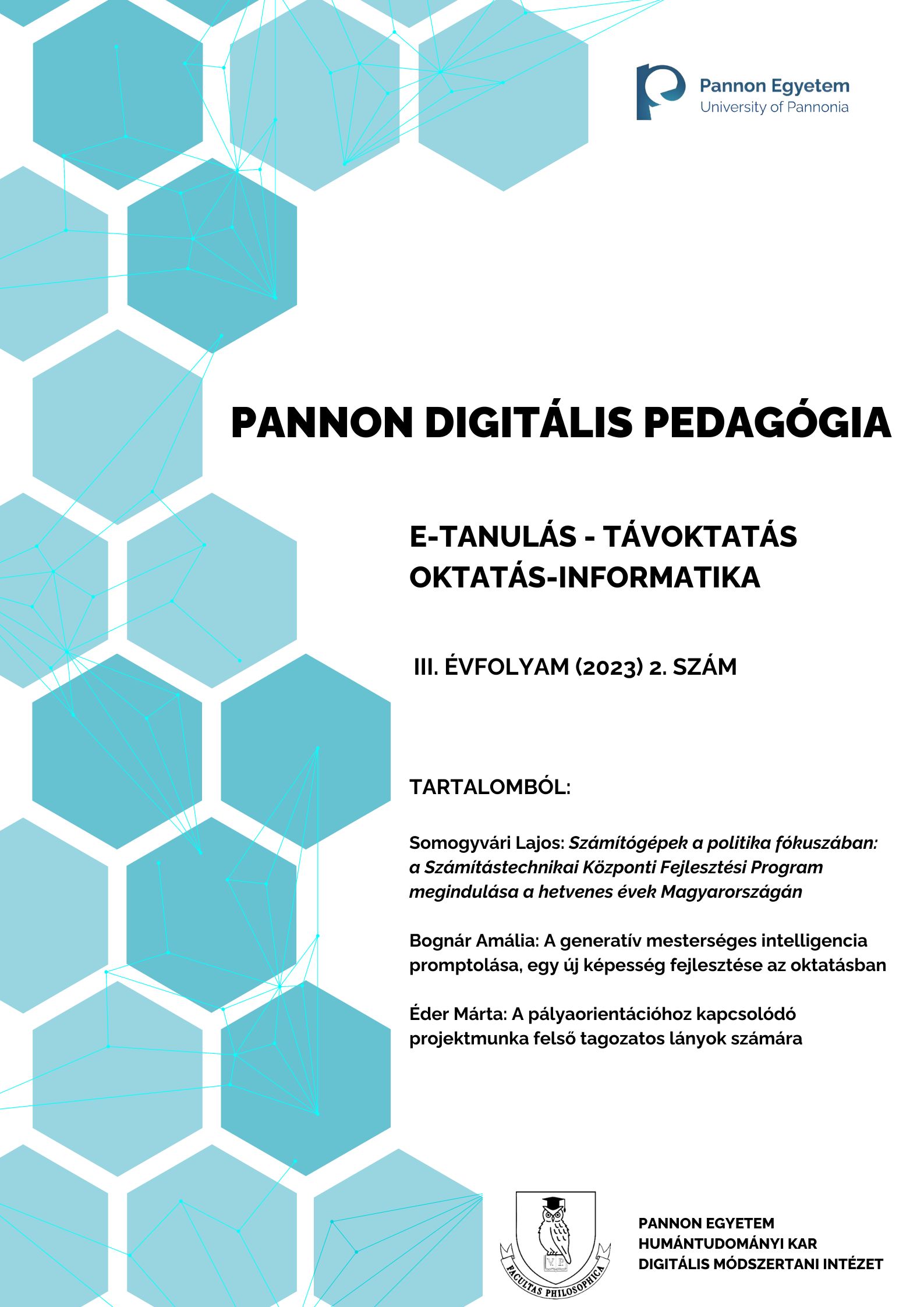Computers in the focus of politics: Beginning of the Central Development Program for Computer Technology in 1970s Hungary
DOI:
https://doi.org/10.56665/PADIPE.2023.2.1Keywords:
technological transfer, school computer, knowledge race in the Cold War, Central Development Program for Computer Technology, history of computingAbstract
The implementation of computers into education has been a less-known topic in the Hungarian history of education. I am going to introduce it focusing on the 1970s, influenced by economic-political needs, educational requirements, and the international environment. My study – as a first step in long-time research – is based on the special archival corpus, minutes of the Hungarian cabinet. It is important to reveal such sources to draw the social and political background of this topic, establishing a more broaden context, than the earlier surveys in the history of computers. Besides the technological circumstances and development, hardware and software dimensions, I will examine other trends, like the narrative of the scientific-technological revolution, the New Economic Mechanism started in 1968 and stopped a few years later. All of these and the growing importance of cybernetic clubs from the 1960s characterized the field. Every European country and the two superpowers feared in the 1970s to lag behind the Cold War “knowledge race”, which resulted in an urgent need for technological transfer. The Central Development Program for Computer Technology was the initiative of the Hungarian government, in the framework of making a unified computer system among socialist countries. Firstly, they had to create the infrastructure, adapt technologies, and make production. I am not going to analyze the success of the project, my central point is utilizing the official cabinet files to describe the beginning of the process: governmental- and party control of research & development, and the different activities of the experts, which were completely unusual in the state socialist system. I am adding newspaper articles on the use of computers in schools to the primary sources: several pedagogical innovations emerged locally, due to self-motivated and enthusiastic teachers. The school computer program was a peak of this trend in the early1980s, but this action is out of my timeframe.
References
Elsődleges források:
A Számítástechnikai Központi Fejlesztési Program. 1971. november 4. MNL XIX-A-83, 483. jegyzőkönyv. A vezetői ismeretek oktatása és a gazdasági szervezetek vezetőinek intézményes továbbképzése (határozat az
Országos Vezetőképző Központ létesítéséről). 1967. október 5. MNL XIX-A-83, 375. jegyzőkönyv.
Jelentés Kádár János és Fock Jenő elvtársak 1970. január 28-30-i berlini látogatásáról. 1970. február 12. MNL XIX-A-83, 438. jegyzőkönyv.
Kormányszinten jóváhagyott fejlesztések, rekonstrukciók, és a hitelből finanszírozott beruházások helyzetéről. 1971. július 29. MNL XIX-A-83, 476. jegyzőkönyv.
Különfélék. 1969. május 25. MNL XIX-A-83, 419. jegyzőkönyv.
Tájékoztató a Gazdasági Bizottság 1971. június 9-i üléséről. 1971. június 17. MNL XIX-A-83, 473. jegyzőkönyv.
Válasz a Szovjetunió kormányának levelére számítástechnikai együttműködés tárgyában. 1968. június 12. MNL XIX-A-83, 395. jegyzőkönyv.
Irodalom:
Balázs, B. (1969). Az elektronikusszámítógépek pedagógiai célú alkalmazása. Magyar Pedagógia, 69(4), 456–458.
Báthory, Z. (1969). Tanulás és nevelés. Nemzetközi szeminárium Svédországban. Köznevelés, 25(1), 30–31.
Bódy, Zs. (2021). Technokrata transznacionálé az 1960-as években és a keleti blokk önállósága a globalizáció szempontjából. Korall, 85. 113–137. https://doi.org/10.52656/korall.2021.03.006
Ceruzzi, P. E. (2003). A History of Modern Computing. The MIT Press, Cambridge, MA – London.
Cowen, R. (2009). The transfer, translation and transformation of educational processes: and their shapeshifting? Comparative Education, 45(3), 315–327. https://doi.org/10.1080/03050060903184916
Fuchs, E. & Roldán Vera, E. (2019, Eds.). The Transnational in the History of Education: Concepts and Perspectives. Springer, Cham. https://doi.org/10.1007/978-3-030-17168-1
Germuska, P. (2004). Indusztria bűvöletében. Fejlesztéspolitika és a szocialista városok. 1956-osIntézet, Budapest.
Howlett, C. (2018). Teacher Education and Posthumanism. Issues in Teacher Education, 27(1), 106–118.
Képes, G. (2005). Kovács Mihály és a kibernetika oktatás kezdetei a budapesti Piarista gimnáziumban. In
Vámos, É. & Vámosné Vigyázó, L. (Szerk.). Mérnök, természettudós és orvos dinasztiák, melyek befolyásolták Magyarország szellemi életét. Országos Műszaki Múzeum – Áron Kiadó, Budapest, 49–53.
Kiss, Á. (1975). Iskolai és permanens nevelés. Magyar Pedagógia, 75(2), 115–128.
Kiss, Á. & Gyaraki, F. (1968). Számítógépek pedagógiai alkalmazása. Pedagógiai Szemle, 18(6), 527–542.
Kovács, M. (1971). Számítógép-ismeretek. Köznevelés, 27(4), 3–5.
Kozma, T. (2016). A pillanat. Esszé az oktatáskutatásról. Új Mandátum Könyvkiadó, Budapest.
Páris, Gy. (1972). Kutatás-fejlesztési feladatok a Számítástechnikai Központi Fejlesztési Programban. Ipargazdaság, 24(8–9), 23–24.
Popkewitz, T. (2013, Ed.). Rethinking the History of Education: Transnational Perspectives on its Questions, Methods, and Knowledge. Palgrave Macmillan, New York. Postlethwaite, N. T. (2016). Educational Research and Policy-Making: A Third Way. Educatio, 10(1), 151–163.
Rankin, J. L. (2018). A People’s History of Computing in the United States. Harvard University Press, Cambridge, MA. https://doi.org/10.4159/9780674988538
Sáska, G. (2015) Tudásverseny és globalizáció. Educatio, 24(2), 98–111.
Scott, J. C. (1998). Seeing Like a State. How Certain Schemes to Improve the Human Condition Have Failed. Yale University Press, New Haven – London. https://doi.org/10.12987/9780300128789
Somogyvári, L. (2014). Tanítógépek Magyarországon a hatvanas években. Létünk, 44, virtuális különszám, 93–104.
Somogyvári, L. (2021). Kiss Árpád és az IEA. In Rébay, M. (szerk.). Pedagógia a (pre)szocializmus korában. Debreceni Egyetem BTK Nevelés- és Művelődéstudományi Intézet, Debrecen, 43–57.
Somogyvári L., Szabó, M. & Képes, G. (2023). How Computers Entered the Classroom in Hungary: A Long Journey from the late 1950s into the 1980s. In Flury, C. & Geiss, M. (Eds.). How Computers Entered the Classroom, 1960–2000. De Gruyter Oldenbourg, Berlin – Boston, 39–73. https://doi.org/10.1515/9783110780147-003, Open Access elérés: https://www.degruyter.com/document/doi/10.1515/9783110780147-003/html
Steiner-Khamsi, G. (2006). The economics of policy borrowing and lending: a study of late adopters. Oxford Review of Education, 32(5), 665–678. https://doi.org/10.1080/03054980600976353
Steiner-Khamsi, G. (2014). Cross-national policy borrowing: understanding reception and translation. Asia Pacific Journal of Education, 34(2), 153–167. https://doi.org/10.1080/02188791.2013.875649
Švelch, J. (2018). Gaming the Iron Curtain: How Teenagers and Amateurs in Communist Czechoslovakia Claimed the Medium of Computer Games. The MIT Press, Cambridge, MA – London. https://doi.org/10.7551/mitpress/10964.001.0001
Szabó, M. (2021). From the East to the West and back Again: Hungary’s Early Years in the Ryad. 2020 Fifth International Conference “History of Computing in the Russia, former Soviet Union and Council for Mutual Economic Assistance countries” (SORUCOM), 27–33. https://doi.org/10.1109/sorucom51654.2020.9465042
Vámos, T. (2002). Sebestyén János. Magyar Tudomány, 108(7), 951–954.

